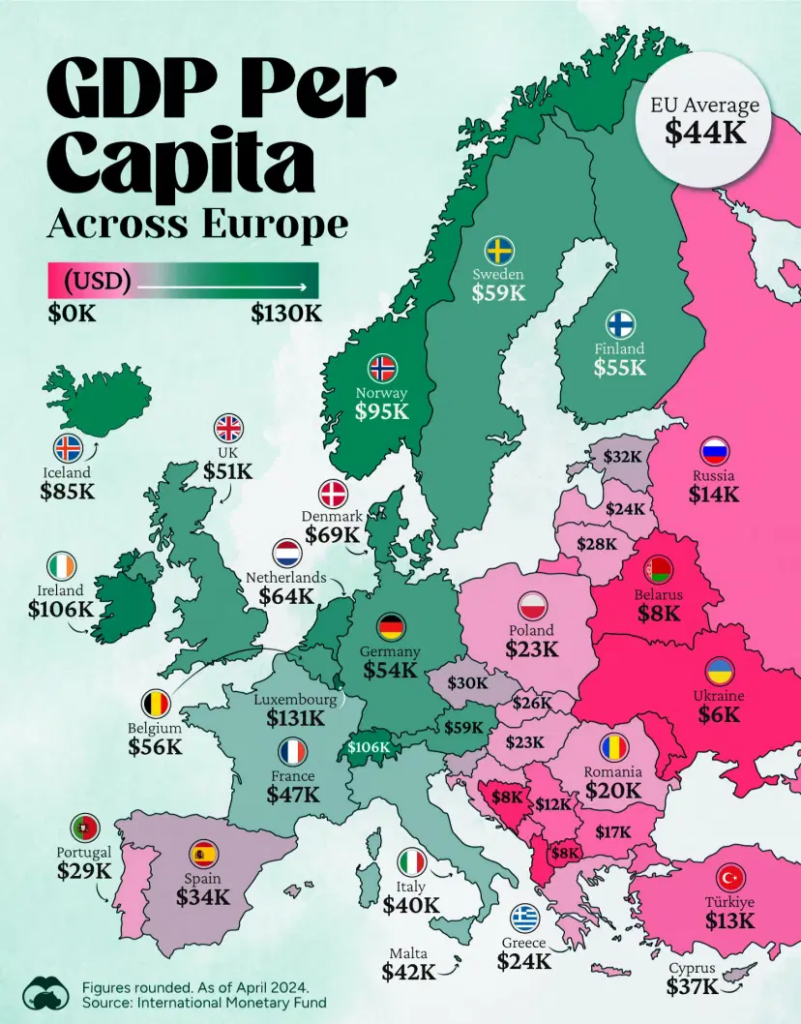Filenews 19 May 2024 - by Theano Thiopoulou
Cyprus ranks 19th in the list of Europe's richest 44 countries based on GDP per capita, according to the new Visual Capitalist ranking.
Cyprus, with a GDP per capita of $37,150, is ahead of Spain and Slovenia, which have $34,050 and $34,030 respectively.
Greece ranks 28th out of 44 countries with $24,000, just above Hungary and Poland.
The country comparisons are based on data from Visual Capitalist (a global online organization that deals with graphics on topics such as markets, technology, energy and the global economy), which compiled graphs showing the respective GDP levels of European countries, in US dollars. The data for this visual and article comes from the International Monetary Fund (via its DataMapper tool), which was updated in April 2024.
If we divide GDP by the total population of a country, we find GDP per capita, which is the average (theoretical) income.
Obviously, GDP per capita does not objectively reflect the distribution of wealth. It may be that those in the richest 10% of the population reap the bulk of the income, regardless of the indication of GDP per capita. However, comparing countries based on GDP per capita remains one of the tried and tested methods.
The richest and poorest nations
According to the data, Luxembourg, Ireland and Switzerland lead the list of Europe's richest nations by GDP capita, with over $100,000.
Three Nordic countries (Norway, Iceland, Denmark) are also placed high, between $70,000-90,000, GDP per capita. Other Nordic countries, Sweden and Finland, rank just below the top 10, with GDP per capita between $55,000-60,000.
Europe's largest economies, in absolute terms, Germany, the United Kingdom and France, rank closest to the middle of the top 20 nations, with a GDP per capita of about $50,000.
At the end of the scale, Eastern Europe as a whole tends to have much lower GDP per capita. In this group is Ukraine, in last place, at $ 5,660.

The table cited by the IMF shows that the GDP per capita of most European countries is significantly smaller than that of the US, with Greece having the lowest level among Europe's advanced economies.
Analytics
According to the ranking list of countries, the top ten countries with high GDP per capita are: Luxembourg $131,380, Ireland $106,060, Switzerland $105,670, Norway $94,660, Iceland $84,590, Denmark $68,900, Netherlands $63,750, San Marino $59,410, Austria $59,230, Sweden $58,530.
– In the second ten are: Belgium $55,540, Finland $55,130, Germany $54,290, United Kingdom $51,070, France $47,360, Andorra $44,900, Malta $41,740, Italy $39,580, Cyprus $37,150 and Spain $34,050.
In the third ten based on GDP per capita are: Slovenia $34,030, Estonia $31,850, Czech Republic $29,800, Portugal $28,970, Lithuania $28,410, Slovakia $25,930, Latvia $24,190, Greece $23,970, Hungary $23,320, Poland $23,010.
In the fourth group by GDP per capita are: Croatia $22,970, Romania $19,530, Bulgaria $16,940, Russia $14,390, Turkey $12,760, Montenegro $12,650, Serbia $12,380, Albania $8,920, Bosnia and Herzegovina $8,420, North Macedonia $7,690, Belarus $7,560, Moldova $7,490, Kosovo $6,390, Ukraine $5,660.
Increase productivity
In the context of gradually strengthening private demand, sustained deflation will require labour productivity to recover and firms' profit margins to return to pre-crisis levels, the IMF report said. For advanced European economies, risks to their soft landing are balanced, according to the Fund, while for many central, eastern and southeastern European economies the risks are one-dimensional, amid high wage growth, more persistent core inflation and persistently high inflation expectations.
Achieving a soft landing is not the only thing that comes first. Europe's per capita income levels are well behind global highs and this gap is not expected to close in the time horizon of its forecasts, the IMF said.
Productivity growth has slowed and population ageing is a big burden. Geo-economic fragmentation casts a shadow over old growth patterns across Europe.
At the same time, increasing long-term spending pressures due to ageing populations, ambitious climate change plans and increased defence spending call for structural fiscal reforms and increase the urgency of sustainable growth growth. "Achieving these goals will not be easy," the report notes, "but Europe has shown that it can overcome even the toughest obstacles when it acts united and decisively."
A closer look at Ukraine
For a broader comparison, Ukraine's GDP per capita is similar to that of Iran ($5,310), El Salvador ($5,540) and Guatemala ($5,680).
According to IMF experts, Ukraine's economy has historically fallen short of expectations. After the fall of the Berlin Wall, the economy contracted for five consecutive years. Its transition to a Western country with a free economic structure was overshadowed by widespread corruption, a limited tax base, and few sources of revenue.
Politically, transforming it from an authoritarian regime into a bourgeois democracy proved difficult, especially in terms of institution-building. Politically, transforming the state from authoritarian regime to bourgeois democracy has proven difficult, especially when it comes to institution building. Finally, following the Russian invasion of the country in 2022, Ukraine's GDP shrank by 30% in a single year – the biggest loss since independence. Large-scale migration – reaching six million refugees – also plays a role.
